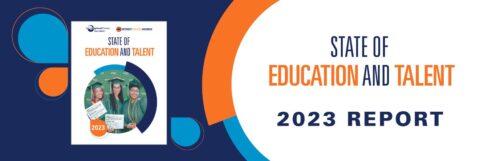Following the Detroit Regional Chamber’s data reveal, University of Michigan’s Santa J. Ono and Henry Ford College President Russ Kavalhuna reacted to the State of Education and Talent report in a conversation with Michigan Public Radio’s Zoe Clark. The presidents offered an optimistic assessment of the state’s chances of improving postsecondary educational attainment and touted efforts underway to support students better and make college more affordable.

Left to Right: Zoe Clark, Russ Kavalhuna, and Santa J. Ono
Highlighting Affordability Programs and Delivering Jobs at End of Talent Pipeline Is Critical to Raising Attainment
With recent examples such as the Go Blue Guarantee and Detroit Promise Scholarship, several programs in the Detroit Region have largely removed tuition costs as a barrier to college, a key step flagged by the presidents. Unfortunately, as the report showed, awareness of such programs tends to be low.
“We have to do more to show a value proposition for students getting in,” said Kavalhuna. “We also need to do a better job showing that the hurdles to getting into higher education are less.”
Raising awareness about in-demand jobs and ensuring good-paying jobs at the end of the Region’s talent pipeline is critical to raising educational attainment and combatting misperceptions that college degrees aren’t worth the cost.
“We have to do a better job connecting (students) with future employment,” said Ono. “We do a very poor job as a sector in articulating where the jobs are from day one and counseling them about the kinds of experiences and internships and co-ops that can really make them competitive once they apply.”
Kavalhuna agreed, hinting that Henry Ford College has a pending announcement about a partnership with Corewell Health that promises jobs to nursing students.
“The gold standard that Santa and I and others in our industry are trying to find is employers who will say, ‘I will invest in these students during the higher education system to pull them through the talent pipeline into a meaningful career,’” Kavalhuna said. “That is the kind of collaboration that we need to have for every single sector that needs better employees in Michigan.”
Improving Graduation Rates Requires a Disproportionate, Intentional Investment in Marginalized Students
Kavalhuna also noted that 65% of Henry Ford College students identify as non-white, with a high percentage of those being economically distressed and marginalized to the point that they often do not view themselves as “college material.”
“I’ll just be candid: we need to give disproportionate investment to those students because it’s the morally right thing to do as an access institution, and it changes people’s lives,” said Kavalhuna. “We are having fewer and fewer high school graduates as a state, and that’s going to be the case for at least the next 10 years. So, we have to take those students that historically have been marginalized outside of this life-changing opportunity that is higher education, and we have to put more and disproportionate resources in lifting them up.”
Ono cited improvements over the past year in first-year retention and six-year graduation rates at U of M’s Dearborn and Flint campuses as reflective of the intentional strategy and investment needed to give pathways to all students.
“In many of these cases, through the Go Blue guarantee, we’re providing a free ride in terms of tuition. So, there are other unmet costs that we have to address. That’s one of the levers to have more of them graduate. But the other is to really wrap around them with support, both curricular and co-curricular so that the student feels that they belong, but also get very specific personal attention and counseling while they’re on campus.”
Kavalhuna cited timely support as the key next step in building the student support system.
“If you hit a bump in the road, whether it’s because you’re helping somebody at home with a family, or you’re working a part-time job, or heaven forbid you have a flat tire, those types of immediate injections of support; my family provided that [for me],” said Kavalhuna. “These students who don’t have that, they’re just one bump away from saying: ‘You know what, college isn’t for me.’”

